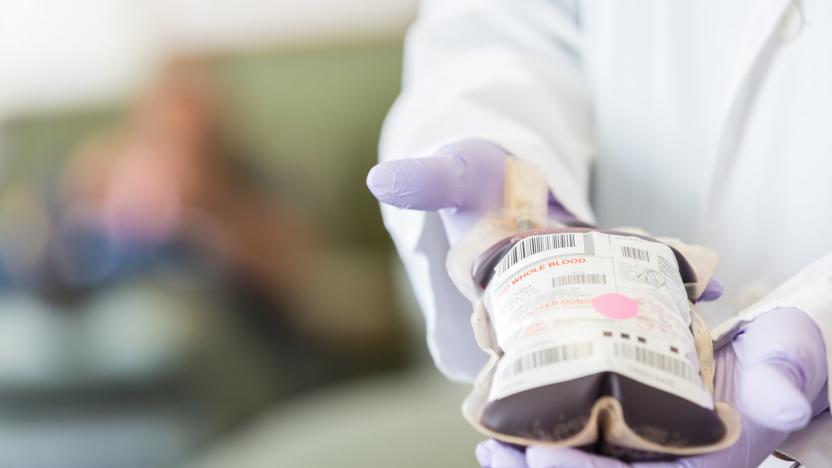UniversityOfBristol
Latest

Silently ‘speak’ to someone across the room with an ultrasonic beam
If you ever wanted to whisper across a crowded room, a new experimental device might let you deliver sneaky instructions -- if the awkward speaker and electrodes don't tip everyone off. Researchers at the University of Bristol built a wearable that translates facial expression into ultrasonic words that can be heard up to 30 meters away.

Mass-produced artificial blood is now a real possibility
Doctors dream of having artificial blood always on hand, but the reality has usually been very different. While you can produce red blood cells in a lab, the current technique (which prods stem cells into action) only nets a small number of them at best. British researchers appear to have found the solution, however: they've developed a technique that can reliably produce an unlimited number of red blood cells. The trick is to create "immortalized" premature red blood cells that you can culture as much as you like, making mass production a real possibility.

ICYMI: Smart coats, robot whiskers and vaporizing lasers
Today on In Case You Missed It: Google and Levi's team up to make a smart Canadian Tuxedo jacket, the University of Bristol teaches a whiskered robot to react to stimuli and Stanford's Linear Accelerator fries water droplets with an X-ray laser, because science!

Rowing robot powers itself by gulping dirty water
One day, you might see robots that not only survive in hazardous environments, but thrive in them. University of Bristol researchers have built Row-bot, a swimming robot that powers itself by feeding on dirty water. Its paddle both propels it forward and helps its microbial fuel cell gulp down the nutrients it needs to generate electricity. This robot might never need refueling so long as it's wading through unpleasant seas, whether they're full of algae or oil.

British scientists create a 'tractor beam' of ultrasonic sound
A team of researchers from the Universities of Bristol and Sussex have developed the world's first functioning sonic tractor beam able to operate outside of a lab environment. The device uses 64 miniature speakers to generate high-amplitude, ultrasonic sound waves. These waves create an "acoustic hologram" (read: force field) capable of moving pea-sized objects without physically touching them. Adjusting the output of individual speakers allows the researchers to move, rotate and hold items at will.

Ultrasound can help wounds heal faster
It might sound a bit like quack medicine, but researchers from the University of Sheffield have proven that sound waves can help accelerate the skin's healing process. In particular, the team has discovered that the vibration low-intensity ultrasound transmits through the skin can activate pathways that fibroblast cells can use to migrate to the wounded area. Those cells are play a crucial role when it comes to the body's ability to repair damaged tissue. That's similar to how a cat's purr -- its frequencies, that is -- can stimulate the regeneration of bones.

Camouflage could soon change colors the same way squid do
Researchers at the University of Bristol have announced they've developed of artificial cephalopod chromatophores -- the specialized cells that allow squid and octopi to instantly change their skin color -- a breakthrough that could lead to real life active camouflage. The team employed a pliable smart material called electroactive dielectric elastomer to create artificial skin. And as you can see in the video below, they programmed the cells to sense what their neighbors were doing (either expanding or contracting) and then do the same. Right now, the cells can only open and close operate linearly. However, the researchers hope to further develop the technology so that future iterations are able to mimic the complex patterns that cephalopods actually produce.

Basics of quantum teleportation now fit on a single chip
Until now, quantum teleportation (that is, sending quantum data from one place to another) has required a room-filling machine. That's not going to usher in a brave new era of quantum computing, is it? However, a team of British and Japanese researchers has shrunk things down to a much more reasonable size. They've stuffed the core optical circuits for quantum teleportation into a single silicon chip that's just slightly longer than a penny -- in contrast, an experimental device from 2013 was nearly 14 feet long. While scientists built the chip using "state-of-the-art nano-fabrication," it should be more practical to make than its ancestors, which took months.

New tech uses ultrasound to create haptics you can 'see' and touch
We've seen haptic feedback in mid-air before, but not quite like this. The folks from Bristol University are using focused ultrasound in a way that creates a 3D shape out of air that you can see and feel. We know what you're probably thinking: How do you see something made of air? By directing the apparatus generating it at oil. As you do. According to the school, the tech could see use in letting surgeons feel a tumor while exploring a CT scan. Or, on the consumer side of things, to create virtual knobs you could turn to adjust your car's infotainment system without taking your eyes off the road. The tech can also apparently be added to 3D displays to make something that's both visible and touchable. If you're curious about what it looks like in action, we've embedded a video just below.

Researchers laugh in the face of flatness with new approaches to haptic displays (video)
If the future of haptic technology is your jam, then the symposium on User Interface Systems and Technology at the University of St. Andrews is the place to be this week. Teams from Disney Research and the University of Bristol will present two different approaches to adding 3D tactility to touch technology, and the results are pretty fascinating. While incorporating haptic feedback into displays isn't unheard of, adapting it to live content has been a challenge. At Disney, researchers developed an algorithm that can translate information culled from depth maps of virtual surfaces into dynamic tactile experiences. Through the magic of electrovibrations, the team was able to simulate changes in texture as a finger slid across a flat surface displaying both static imagery and live video. The group from Bristol opted for a different strategy; instead of vibrations produced by electricity, their UltraHaptics system relies on ultrasound speakers embedded behind a display used in conjunction with a Leap Motion controller. Basically, high-frequency sound waves produce an invisible field that creates a sensation of texture without the user having to touch the screen at all. Interest piqued? Check out videos of both systems in action after the break.

Bristol physicists working to bring quantum cryptology to our phones
It's no secret that our phones are often vulnerable to the occasional malicious hack, no matter how much we believe our passwords to be secure. But what if the encryption methods we used were based on the laws of physics instead of just mathematical formulas? The answer might just lie in quantum cryptology or quantum key distribution, which uses photon modification to encode and transmit data. However, the technology has typically required gear only found in top laboratories. Both sender and recipient need to have a source of those photons, the equipment has to be perfectly aligned and the encryption tends to be highly susceptible to noise. Yet, Jeremy O'Brien and his physicist cohorts from the University of Bristol might have come upon a mobile-friendly solution. Their proposed method only requires the transmitting party to have the appropriate photon-sending equipment while the recipient needs just a simple device -- say, a phone -- to change them and send the information back. Called "reference frame independent quantum key distribution" or rfiQKD, the technique is robust enough to not rely on proper alignment and is apparently able to withstand a high level of noise as well. In a recent paper submitted to arXiv.org, O'Brien and his co-authors state that "the results significantly broaden the operating potential for QKD outside the laboratory and pave the way for quantum enhanced security for the general public with handheld mobile devices." While we're not sure if the method will solve all our security woes, it's certainly a start. If you feel you're able to grok the science, head on over to the source for more details on the team's findings.

Researchers wrangle microscopic particles with sonic lasso
When you think about it, scientists and cowboys have a lot in common. Both are frontiersmen of a sort, both wear clothes that make them easy to identify and now they both count lassos among their essential tools. Researchers at the University of Bristol and the University of Dundee have wrangled small particles and cells by using a sonic (or ultrasonic) vortex. The whirl of sound waves allowed the teams to catch, move and orient microscopic particles, all without actually contacting them physically, which makes the solution ideal for handling delicate material. Professor Bruce Drinkwater from Bristol even suggested it could one day be used to assemble human tissue (custom assembled livers, anyone?). The sonic lasso is quite a bit more complex and less portable than its rope-based cousin, involving a circular device with 16 sources of acoustic waves. If you're looking for more technical details you'll find a link to the recently published paper titled, Dexterous manipulation of microparticles using Bessel-function acoustic pressure fields at the source.

Environmentally friendly robots will feed the flowers they trample
Dr Jonathan Rossiter, a senior lecturer at the University of Bristol's Department of Engineering and Mathematics, has snagged a two-year research grant of over £200,000 to develop robots that decompose once their mission if complete. This means instead of our automaton friends rusting away, devoid of purpose, they could return gracefully (and more importantly non-toxically) back to mother earth. Not only would this be a boon to the environment, but scientists would no longer need to track and retrieve their mechanical progeny once it reached the end of its usable life, further sparing resources and allowing mass deployment. At least we know, when the day comes, the planet won't be harmed.

Magnetic soap could make your next oil spill less oily
Instead of spending millions upon millions to clean up the next oil spill, why don't we just all pitch in and buy some soap? That's basically what researchers at the University of Bristol are proposing, with a new kind of soap that's apparently like no other. This soap, you see, is magnetic, which means it could be easily removed from water without leaving behind any hazardous chemicals -- a potentially major selling point for cleanup crews and environmentalists alike. To create it, the team collected water with chlorine and bromine ions, and used it to dissolve iron particles, creating a metallic core. They proceeded to test their creation by placing the soapy particles within a test tube, underneath layers of water and oil. Much to their delight, they were able to remove the particles with only a magnet, ostensibly providing a template upon which disaster response crews may build.

Scientists claim equation can predict songs' hit potential; still doesn't help David Hasselhoff
Forget Simon Cowell -- when it comes to having an eye for potential hits, the bright minds over at the University of Bristol in the UK believe they can predict a song's hit potential through good, old science. More specifically, the scientists use a "hit potential equation" that they've devised by factoring in 23 musical features like tempo, loudness, harmonic simplicity and danceability. By using the equation, they claim that they can predict a song's hit potential with an accuracy rate of 60 percent. As for that other 40 percent, well, they say it's due to non-musical factors they couldn't account for like, um, marketing. The equation's biggest challenge? Predicting hit songs from the '80s.

Groundbreaking photonic chip could spark Quantum Computing revolution
Quantum Computers already exist, but not in the "universal" form that would truly revolutionize computing. That's why the latest innovation from Bristol University has so much promise: a team from its center for Quantum Photonics has built a reprogrammable quantum chip. The 70mm x 3mm box is capable of measuring and manipulating entanglement and mixture -- fundamental elements of the mythical "universal" chip. It's taken the team six years to reach this point, but now it'll concentrate on scaling up the technology to create more complex systems, hopefully in time for our next smartphone purchase.

Quantum refrigerator could cool your quantum computer, allow for quantum overclocking
The quantum computer is still ranking pretty high up there on the vaporware charts, somewhere between Duke Nukem Forever and a Steorn in-home power generator. Eventually we'll get there, and theoretical physicists at the University of Bristol are helping with a quantum cooling system. It is effectively a means for two qubits to cool a third, with the outer two cooled by lasers and absorbing energy from the third, which is heated to its excited state. Unsurprisingly this is all rather theoretical at this point, but the team does plan to actually build such a quantum refrigerator in the not too distant future. Then, we figure, they'll host the first quantum kegger.

Video: Jules the robot makes convincing argument to destroy humanity
Besides rarely showering, Robotic engineers and researchers also possess a peculiar sense of humor. Trip with us through the uncanny valley as we take a look at the animatronic head developed by David Hanson. Software, developed by the University of Bristol with some help by a professional animator, controls 34 tiny servo motors to mimic facial expressions picked up by Jules' camera. Watch Jules make an ecologically sound case to "destroy humanity" in the video after the break. Indeed, if only Maggie was still in power.

Researchers demo "unbreakable encryption" based on quantum cryptography
Call us devilish, but we just can't help but love these types of stories. Here we have yet another overly confident group of researchers grossly underestimating the collective power of the hacking underground, as gurus from all across Europe have joined together to announce "the first commercial communication network using unbreakable encryption based on quantum cryptography." Interestingly enough, quantum cryptography has already been cracked in a kinda-sorta way, but that's not stopping these folks from pushing this claim hard to government agencies, financial institutions and companies with distributed subsidiaries. We've no doubt this stuff is pretty secure, but the last time we heard someone utter a claim similar to this, we saw him uncomfortably chowing down on those very words merely months later.[Via Physorg]













